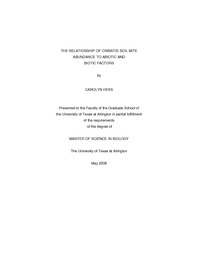
ATTENTION: The works hosted here are being migrated to a new repository that will consolidate resources, improve discoverability, and better show UTA's research impact on the global community. We will update authors as the migration progresses. Please see MavMatrix for more information.
Show simple item record
| dc.contributor.author | Hess, Carolyn | en_US |
| dc.date.accessioned | 2008-08-08T02:31:19Z | |
| dc.date.available | 2008-08-08T02:31:19Z | |
| dc.date.issued | 2008-08-08T02:31:19Z | |
| dc.date.submitted | May 2008 | en_US |
| dc.identifier.other | DISS-2107 | en_US |
| dc.identifier.uri | http://hdl.handle.net/10106/1004 | |
| dc.description.abstract | Oribatid soil mites primarily feed on fungi and dead organisms. They belong to the arthropod subclass, Acari, that are believed to contribute to soil processes such as plant litter breakdown and nutrient release. In order to facilitate more accurate predictions about obscure soil processes, research has been done that has attempted to correlate soil mite abundance and diversity to more easily measured aboveground biota.
The present study examined monthly Oribatid soil mite abundance and its relationship to four different plant communities in North Texas: mowed grass monoculture, un-managed field, riparian, and woodland, during one growing season. Due to the nutritional additions of plant litter to the soil communities, the woodland and riparian sites were expected to have the highest mite abundance, followed by the field, and grass sites respectively. Also examined was the relationship between soil moisture and Oribatid abundance, with greater moisture levels expected to positively correlate with mite abundance, as suggested in the literature. Due to the minimizing effects of the tree canopy on evapotranspiration, the woodland and riparian sites were expected to retain the most moisture, followed by the field and grass sites respectively. The effects of seasonal progression on Oribatid abundance were expected to be minimal, since the season's litter contribution to the soil is not immediately available to soil organisms.
Oribatid and total arthropod abundance were significantly greater in the grass monoculture over the course of sampling than in the other plant community types. The repeated addition of the grass clippings during peak growth and productivity provided high quality nutrients to the soil, ultimately enabling the Oribatid mite population to thrive. This finding could also have resulted from the relative success of the Bermuda grass in the unusually rainy season, the success of a few species in the empty niche caused by the absence of others, or sampling effects. These results indicate a need for further research at the site in order to illuminate its underlying cause. The effects of moisture on mite abundance were contradictory. The woodland soil did indeed contain the most moisture, but moisture did not correlate positively with mite abundance as expected. Slight time effects were present but unexplained, which indicate a need for further research on seasonal effects. Further research is thus recommended to explain the unexpectedly high Oribatid abundance in the mowed grass monoculture, as well as the lack of moisture correlation with Oribatid abundance, as predicted based upon previous literature. | en_US |
| dc.description.sponsorship | Gough, Laura | en_US |
| dc.language.iso | EN | en_US |
| dc.publisher | Biology | en_US |
| dc.title | The Relationship Of Oribatid Soil Mite Abundance To Abiotic And Biotic Factors | en_US |
| dc.type | M.S. | en_US |
| dc.contributor.committeeChair | Gough, Laura | en_US |
| dc.degree.department | Biology | en_US |
| dc.degree.discipline | Biology | en_US |
| dc.degree.grantor | University of Texas at Arlington | en_US |
| dc.degree.level | masters | en_US |
| dc.degree.name | M.S. | en_US |
| dc.identifier.externalLink | https://www.uta.edu/ra/real/editprofile.php?onlyview=1&pid=83 | |
| dc.identifier.externalLinkDescription | Link to Research Profiles | |
Files in this item
- Name:
- umi-uta-2107.pdf
- Size:
- 957.2Kb
- Format:
- PDF
This item appears in the following Collection(s)
Show simple item record


